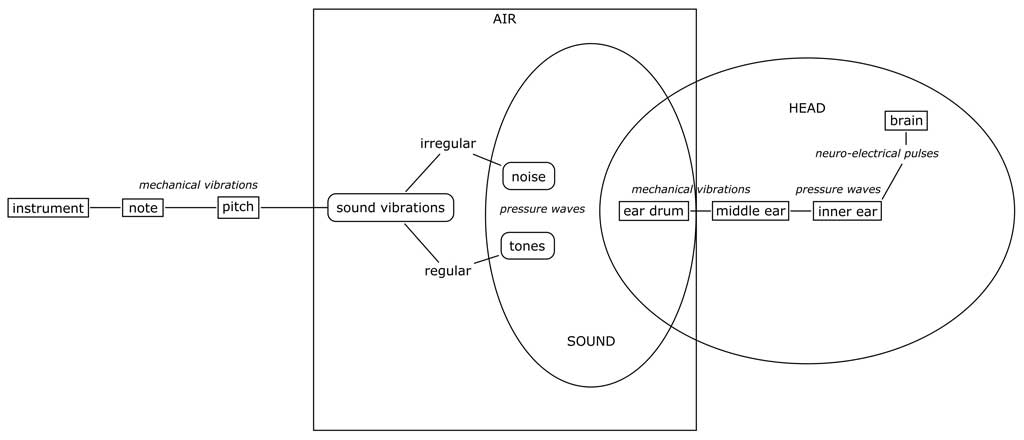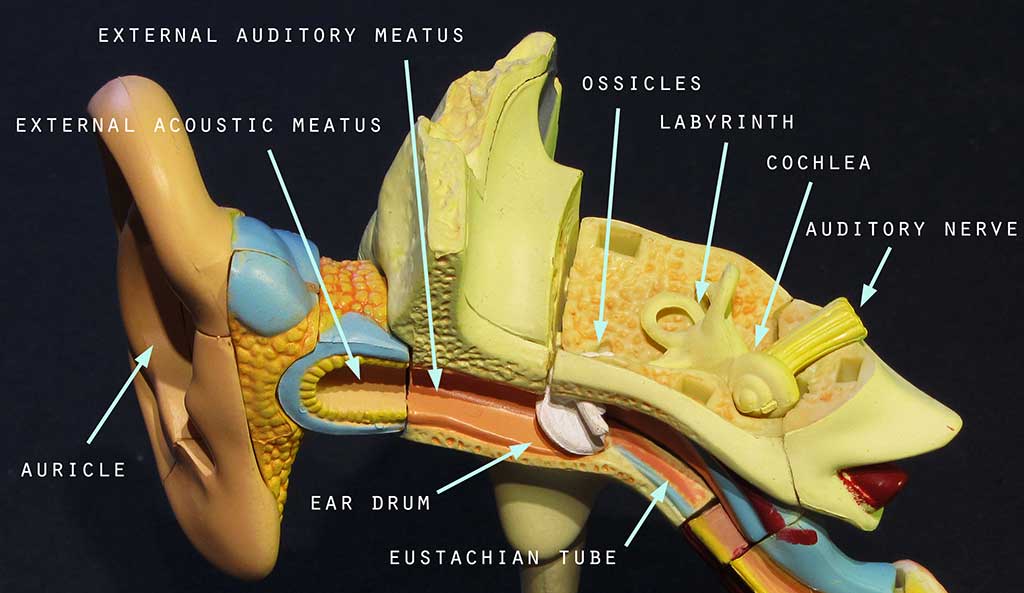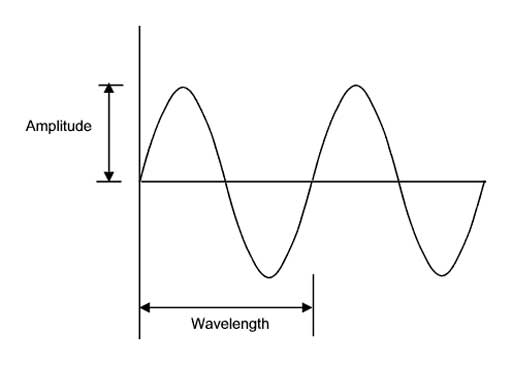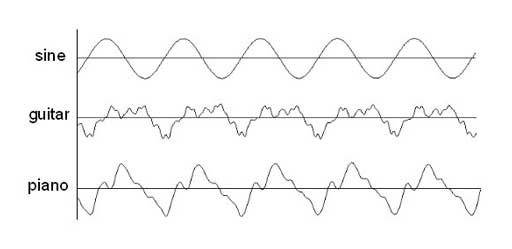 Chapter 2 of the Outline of basic music theory – by Oscar van Dillen ©2011-2020
Chapter 2 of the Outline of basic music theory – by Oscar van Dillen ©2011-2020
The beginner’s learning book can be found at Basic elements of music theory.
Overview of chapters:
Chapter 1: Introduction
Chapter 2: Sound and hearing
Chapter 3: Musical notation
Chapter 4: Basic building blocks of melody and harmony
Chapter 5: Consonance and dissonance
Chapter 6: Circle of fifths and transposition
Chapter 7: Concerning rhythm, melody, harmony and form
Chapter 8: Further study
Sound
Sound is the perceived complex phenomenon of vibrations traveling as pressure waves through a medium. For all living beings on earth this medium is either air or water. Such vibrations are called sound when they are perceived by (our) hearing.
There are thus three components in sound: vibration, medium, hearing. Generally, silence is considered to be the opposite of sound.
In music, silence is always relative to sound and sound volume, just as in visual art darkness is relative to light and lightness.
Parameters of sound
A musical sound can be recognized and defined by its pitch (or frequency), duration (or relative rhythmic value), timbre (color or instrument), dynamics (loudness) and position in space (relative to the listener)1. These musical parameters furthermore include the following concepts when applied to groups of sounds: register position(s), density, color palette, general loudness level(s) and spatial distribution(s). All music consists of related sounds and silences, which can be symbolized by notation.
Hearing
Sound is perceived by our hearing, which is a result of our ears picking up vibrations in the air and translating these to our brain, where the perception of hearing comes to awareness2.

perception of sound
The ear translates vibrations in the ear into neural signals. Air-vibrations are received by the ear drum (tympanic membrane) and transmitted by means of the three extremely small bones called ossicles (as the fossil record shows, these originally evolved from jaw bones hundreds of millions of years ago), whose intricate lever-function is to reduce the amplitude of the vibration while increasing the energy transmitted, to the inner ear (labyrinth). The middle ear thus translates pressure waves (back) into mechanical vibrations. The inner ear serves two functions, those of hearing and of balance. The cochlea is the coiled part of the inner ear which translates the mechanical vibrations into pressure waves in its internal fluid, which are picked up by hair cells that convert their motion into electrical signals. These are in turn interpreted by nerve cells that transform them into electrical impulses that travel through the auditory nerve to structures in the brainstem for further processing. Hearing is a complicated mechanism!

anatomy of the ear
Apart from having a vested interest in keeping one’s ears in perfect condition3, what most concerns musicians here, and hence music theory, is basic knowledge about vibrations, especially those that we recognize as tones, as pitches.
Physics of sound
A tone is a complex combination of a series of regular vibrations, usually with one prominent frequency which is experienced as the pitch. A regular vibration is scientifically named a frequency, expressed in Hz (Herz), cycles per second.

sine wave
The amplitude of such a wave corresponds directly to the volume of a sound, the wavelength to its pitch, or frequency. Standard tuning in music today is usually to A=440Hz45 which means there are 440 vibrations per second to produce this tone. Although human hearing ranges between 25 to 20,000 Hz, the pitches actually used in music are roughly between 25 and 5,000 Hz.
Ultrasound, sound too high for human perception, is used by animals such as dolphins6, bats7 and mice.8
Infrasound, sound too low for human perception9, is found in larger animals such as hippos, elephants10 and whales11.
The basic regular vibration is a sine-wave, but all musical instruments actually produce a combination of various sine waves for each tone. Differences in these combinations are perceived as various colors of sound. Some examples of oscillograms are given below12.

wave graphs comparison
Most animals have a very different hearing (and correspondingly: sound producing) range from us humans. For example, elephants and whales hear and communicate with subsonic frequencies (infrasound) over vast distances, whereas bats and dolphins use a sonar system employing extremely high frequencies (ultrasound) to locate their prey at short range, especially in conditions where sight will not avail them13.
Various tones overlapping or sounding together will produce generations of audible combination tones in the inner ear, sum- and difference tones coming from the interference of their compound frequencies, producing complex harmonies and tensions between different tones, described by the subjective concepts consonance and dissonance.
Oscar van Dillen ©2011-2020
goto chapter 3 ► Musical notation
Footnotes
- These five dimensions of sound were first described as such by Karlheinz Stockhausen, in his article Musik im Raum (Die Reihe 5, Vienna 1959). ↩
- On the further possible semantic difference between hearing and listening the auditory neuroscientist Seth S. Horowitz wrote the interesting article On the science of listening, New York Times, 9 November 2012 ↩
- Adding Insult to Injury: Cochlear Nerve Degeneration after “Temporary” Noise-Induced Hearing Loss by Sharon G. Kujawa and M. Charles Liberman ↩
- On the history of the tuning standard: Standard pitch or concert pitch for pianos; Barrie Heaton, 1998-2012 ↩
- On fashionable deviations from standard tuning: Hertz So Good? 432Hz Examined; Milton Mermikides, 2014 ↩
- Top 7 ultrasound emitting animals – Softpedia ↩
- Bats and ultrasound – hyperphysics.phy-astr.gsu.edu ↩
- How male mice lure their ladies with song – The Times Science ↩
- Infrasonic sound – hyperphysics.phy-astr.gsu.edu ↩
- Elephant language – The Cornell Lab ↩
- How whales hear – Carnegie museums ↩
- Frequency ranges overview of tones and instruments at zytrax.com ↩
- See more on BBC Soundwaves series ↩
